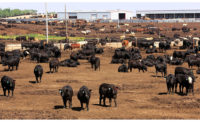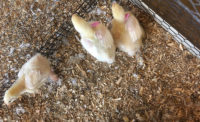One of my favorite parts of being a graduate assistant is having the privilege of working with students and farmers to teach them how to properly process birds in a backyard setting. Experiencing poultry production first-hand, especially students, allows them to observe and interact with where meat products come from and how to safely handle raw products. For me, this is a very rewarding experience because it’s not only teaching them a skill, it allows me to learn new ways to teach an old tradition.
At a recent session, I was asked an odd question about a bird that looked a little different than the rest. The student asked if it had a tumor on its chest. At first, I was baffled at the question. When we thoroughly examined the bird, we could see it was a dropped crop. Of course, the follow-up question I received was, “What’s a dropped crop?”
The crop is the first part of the digestive tract before the proventriculus and the ventriculus, more commonly known as the gizzard. Although the crop is considered part of the digestive tract, it appears to be used more for food storage than digestion of feedstuffs, especially in chickens and turkeys. There is some digestion that can take place in the crop, which is carried out by amylase, an enzyme that initiates the breakdown of carbohydrates. The crop also has many other physiologically important roles other than feedstuff storage, which vary based on the species.
Even though broilers are known for their excessive feeding habits, dropped crops are not as common in chickens as they are in turkeys. The ways by which we manage poultry may be increasing the prevalence of dropped crops. Although the cause of pendulous crop formation is not well-defined, there are several environmental and feeding regiments that can lead to dropped crops.
Dropped crops range in severity from a barely noticeable bump, to an obvious, pendulous crop that hangs down off the front of the bird. The pendulous crop can cause meat quality issues and poses severe threat to bird health. Once the crop becomes distended to the point of protrusion, there is no known management practice to reverse this issue.
Feed conversion and utilization of foodstuffs within the bird become severely hindered, and birds become emaciated once the crop becomes pendulous. Although these birds are still eating, the amount of feed that passes through the crop into the digestive tract significantly decreases. The extra feed gets stuck in the crop and can no longer pass into the proventriculus.
This adds an additional problem once the birds arrive at the harvesting facility. When a bird with a dropped crop arrives for processing, there must be increased care taken to reduce crop contamination.
Most birds can reduce the amount of material located in the crop with adequate feed withdrawal time, which makes it easier to pull crops during evisceration. This is not the case, however, for a distended crop. A large amount of feed will still be present in the crop and will not pass through the digestive tract, stretching the crop tissue and making it very susceptible to tearing. Should it tear, the contents of the crop can contaminate the remainder of the bird, leading to condemnation of the carcass and increased time to clean areas that have been contaminated with crop contents.
At this point, it can only be theorized there are several animal welfare issues that can arise for birds with this condition. Aside from impaired ability to convert feed properly, we also must consider conspecifics and bird behavior. Poultry species are known for their pecking order as part of their dominant social hierarchy. For instance, turkeys have naturally increased aggression levels in which conspecifics will cannibalize or continue to peck lower-hierarchy birds until these injured birds must be euthanized or are found dead.
Birds with pendulous crops are impaired because the crop hinders the ability to deflect away from these aggressive attacks compared with other birds that do not have a pendulous crop. In addition, for birds that have not gone through toe trimming to decrease the prevalence scratches and wound formation, having a distended crop increases the chances the bird may be scraped or the crop will be punctured in a way that causes unnecessary pain and suffering.
Although there are several theories as to what causes dropped crops, there is no way to cure a crop once it has become pendulous. Drop crops have a higher prevalence during decreasing day length. This phenomenon is thought to be caused when birds gorge themselves with feed in a shorter amount of time, given the shorter days.
Diet can also affect drop crop rates. For example, wheat has different properties than corn or soybean in a diet and may affect the digestibility of a feed. Comparatively, a sticky texture can develop from wheat compared with corn during digestion, which may influence the bird’s ability to properly pass feed through the crop. Link this sticky feed with decreased water intake, and soon dropped crops can become an issue.
Crop health is imperative, and dropped crops are not the only crop-related injuries that can occur. There are a few preventative measures to ensure the best crop health. Most important is allowing birds access to fresh water at all times. As dropped crops correlate to shortened day lengths, they can occur seasonally. Limit feed withdrawal times. Feed withdrawal is a food-safety measure necessary in poultry production and as a management tool, such as on-off day feeding. With commercial birds, limiting feed restriction times can benefit the bird by preventing it from overeating, and it will also reduce the occurrence of crop content once birds are processed.
Unfortunately, if a bird is diagnosed with a severe, pendulous dropped crop, the best management practice is to euthanize the bird humanely. This is not only for the bird’s welfare, but it can also reduce production costs.
Once these birds are taken out of the equation, producers will have a more accurate feed conversion ratio since it will only be factoring in birds that are storing feed and properly converting it into muscle. As always, there is not an easy one-size-fits-all cure to this problem; however, by documenting management practices regularly, such as types of feed, water consumption, incidences of dropped crops can help us as an industry to solve this increasing problem in a timely manner. NP






Report Abusive Comment